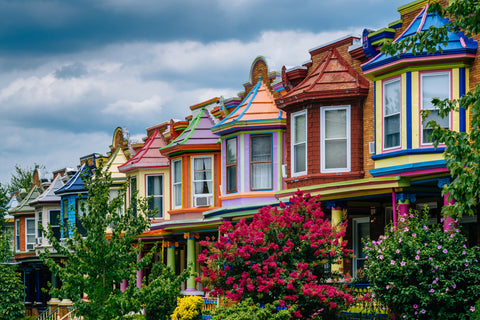Neighborhood Fiber Company's Story
What led to you becoming a yarn producer?
I’m Karida, and I became enamored with yarn after learning to knit in college.
 Shortly after, I started working in a yarn store in Washington, D.C., and I began to develop my own sense of color. Many companies were inspired by organic matter - like flowers and landscapes - but I wanted to develop a palette that felt distinctly urban. I grew up in Tennessee, but my mother and her parents are from Baltimore originally, where my grandparents owned a grocery store on Bentalou Street. I’ve since moved to Baltimore myself, after living in DC and Columbus, OH, and feel like Neighborhood Fiber Co. has grown to reflect Baltimore’s beauty. Our yarns are named after neighborhoods, artists, and landmarks here, and it’s a great way to teach people about Baltimore’s history, geography, and culture.
Shortly after, I started working in a yarn store in Washington, D.C., and I began to develop my own sense of color. Many companies were inspired by organic matter - like flowers and landscapes - but I wanted to develop a palette that felt distinctly urban. I grew up in Tennessee, but my mother and her parents are from Baltimore originally, where my grandparents owned a grocery store on Bentalou Street. I’ve since moved to Baltimore myself, after living in DC and Columbus, OH, and feel like Neighborhood Fiber Co. has grown to reflect Baltimore’s beauty. Our yarns are named after neighborhoods, artists, and landmarks here, and it’s a great way to teach people about Baltimore’s history, geography, and culture.

Where do you create? Do you have a team?
Our team is comprised of photographers, writers, artists, and dye experts - we put our skills and passion for yarn together to develop new colors and to market them. Right now, our studio is housed in a 150-year-old firehouse, but we recently bought a building in the Midway neighborhood; we hope to be moved into this new location by fall of ‘22.
 |

|
What inspires you?
People have a preconceived notion of what Baltimore is like, one that is often negative. By taking inspiration directly from this city, we engage our customers from out of town to learn more about our home, and bring joy to local folks who find their neighborhood among our colors. When people visit the shop, they get to chat with our associates, some of whom are lifelong Baltimoreans, who can explain the reasoning behind what neighborhood is paired with which color, leading to conversations about Black history, redlining, the arts scene, and more.

Can you walk us through one of your yarns from start to finish?
The majority of our yarns begin in New Zealand, where the organic Merino is sourced from, and then spun in Canada. Those yarns - our Studio line, Capital Luxury line, and our Rustic Fingering, are delivered to us in cones, at which point we wind it into skeins to prepare for dyeing. Our Loft base is made in South Africa, where the mohair is sourced from a farm that adheres to the Responsible Mohair Standard - this yarn is delivered to us pre-skeined and ready for the dye kitchen. Once it’s dry, we twist and label each skein, and then it’s ready to sell.
Depending on the fibers and colors we’re dyeing, we can typically dye 30 bundles of tonal and semi-solid yarn a day on our industrial stove. Speckle colors take a little longer, since we dye a base color first and then speckle them in pans (but the effect is so worth the time).




